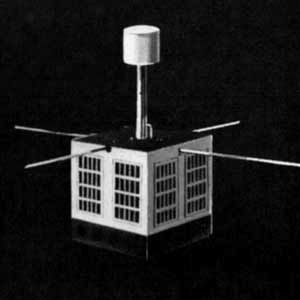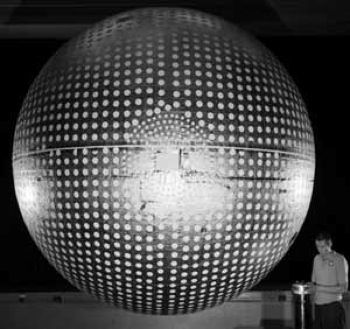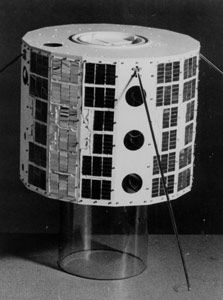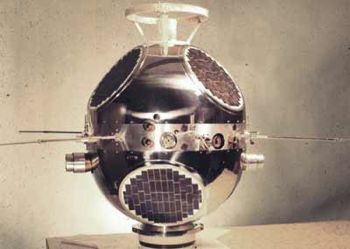
Home - Search - Browse - Alphabetic Index: 0- 1- 2- 3- 4- 5- 6- 7- 8- 9
A- B- C- D- E- F- G- H- I- J- K- L- M- N- O- P- Q- R- S- T- U- V- W- X- Y- Z
Injun
 Injun 2 Credit: Manufacturer Image |
Status: Operational 1961. First Launch: 1961-06-29. Last Launch: 1968-08-08. Number: 5 .
NASA NSSDC Master Catalog Description
Injun 5 (Explorer 40) was a 71-kg magnetically oriented spacecraft and was launched by a Scout rocket, together with a 3.65-m inflatable balloon (Explorer 39) used for air density measurements. Injun 5 was designed to accomplish the following objectives: (1) comprehensive study of the downward flux of charged particles, (2) study of very low frequency (VLF) radio emission in the ionosphere associated with the downward flux, (3) study of geomagnetically trapped protons, alpha particles, and electrons, (4) observation of solar cosmic rays, (5) observation of the continuing decay of the Starfish artificial radiation belt, and (6) study of the temperature and density of electrons and positive ions of thermal and near thermal energy. The spacecraft systems performed normally except for the malfunction of the solar cell power dump device (shortly after launch) which caused the solar cells to deliver a lower power level to the experiments and reduced the time during which the onboard tape recorder could be run. The passive magnetic alignment became effective in mid-December 1968. The spacecraft was turned off from May 31, 1970, to February 18, 1971, after this period it was turned on again. The spacecraft was put in an operational off-mode in early June 1971, and became inoperable shortly thereafter.
NASA NSSDC Master Catalog Description
Injun 4 (Explorer 25) was a magnetically aligned satellite launched simultaneously with Explorer 24 (AD-B) (Air Density experiment) using a Scout rocket. The satellite's primary mission was to make measurements of the influx of energetic particles into the earth's atmosphere and to study atmospheric heating and the increase in scale height which have been correlated with geomagnetic activity. Studies of the natural and artificial trapped radiation belts were also conducted. A biaxial fluxgate magnetometer was used to monitor the orientation of the spacecraft with respect to the local magnetic field. Injun 4 was equipped with a tape recorder and analog-to-digital converters. The satellite power was derived from rechargeable batteries and solar cells. A transmitter operating in an AM mode at carrier frequency 136.29 MHz was used to transmit real-time data, and one operating in a PM mode at 136.86 MHz was used to transmit tape recorder data. Stable magnetic alignment was not achieved until late February 1965. The satellite sent radiation data until December 1966 and is expected to be in orbit for about 200 yr.
| Injun 1 Research, ionosphere satellite for University of Iowa, USA. Launched 1961. |
| Injun 2 Research, ionosphere satellite for University of Iowa, USA. Launched 1962. |
| Injun 3 Research, ionosphere satellite, USA. Launched 1962. |
Family: Earth, Magnetosphere sat. Country: USA. Launch Vehicles: Thor, Delta, Scout, Thor Ablestar, Thor Agena D, Scout X-4, Scout B. Projects: Explorer. Launch Sites: Cape Canaveral, Vandenberg, Cape Canaveral LC17B, Vandenberg SLC2E, Vandenberg SLC5. Agency: USAF, U.S. Navy. Bibliography: 2, 279, 6.
 | Explorer 39 Credit: Manufacturer Image |
 | Explorer 40 Credit: Manufacturer Image |
 | Injun 1 Credit: Manufacturer Image |
 | Injun 3 Credit: Manufacturer Image |
 | Explorer 25 Credit: Manufacturer Image |
1961 June 29 - . 04:22 GMT - . Launch Site: Cape Canaveral. Launch Complex: Cape Canaveral LC17B. LV Family: Thor. Launch Vehicle: Thor Ablestar.
- Injun 1 - . Mass: 25 kg (55 lb). Nation: USA. Agency: USN. Class: Earth. Type: Magnetosphere satellite. Spacecraft: Injun. USAF Sat Cat: 117 . COSPAR: 1961-Omicron-2. Apogee: 992 km (616 mi). Perigee: 869 km (539 mi). Inclination: 66.80 deg. Period: 103.60 min. Dual launch; failed to separate from Solrad 3; still returned radiation data. Space craft engaged in investigation of spaceflight techniques and technology (US Cat A). .
1962 January 24 - . 09:30 GMT - . Launch Site: Cape Canaveral. Launch Complex: Cape Canaveral LC17B. LV Family: Thor. Launch Vehicle: Thor Ablestar. FAILURE: Failure.
1962 December 13 - . 04:07 GMT - . Launch Site: Vandenberg. Launch Complex: Vandenberg SLC2E. LV Family: Thor. Launch Vehicle: Thor Agena D.
- Injun 3 - . Mass: 52 kg (114 lb). Nation: USA. Agency: USAF, USN. Class: Earth. Type: Magnetosphere satellite. Spacecraft: Injun. Decay Date: 1968-08-25 . USAF Sat Cat: 504 . COSPAR: 1962-B-Tau-2. Apogee: 2,406 km (1,495 mi). Perigee: 240 km (140 mi). Inclination: 70.30 deg. Period: 112.10 min. Radiation decay data. Space craft engaged in investigation of spaceflight techniques and technology (US Cat A). .
1964 November 21 - . 17:09 GMT - . Launch Site: Vandenberg. Launch Complex: Vandenberg SLC5. LV Family: Scout. Launch Vehicle: Scout X-4.
- Explorer 25 - . Payload: Injun 4. Mass: 40 kg (88 lb). Nation: USA. Agency: NASA Langley. Program: Explorer. Class: Earth. Type: Magnetosphere satellite. Spacecraft: Injun. USAF Sat Cat: 932 . COSPAR: 1964-076B. Apogee: 2,319 km (1,440 mi). Perigee: 526 km (326 mi). Inclination: 81.30 deg. Period: 114.30 min. Radiation data. Spacecraft engaged in research and exploration of the upper atmosphere or outer space (US Cat B). .
1968 August 8 - . 20:12 GMT - . Launch Site: Vandenberg. Launch Complex: Vandenberg SLC5. LV Family: Scout. Launch Vehicle: Scout B.
- Explorer 40 - . Payload: Injun E. Mass: 70 kg (154 lb). Nation: USA. Agency: NASA Langley. Program: Explorer. Class: Earth. Type: Magnetosphere satellite. Spacecraft: Injun. USAF Sat Cat: 3338 . COSPAR: 1968-066B. Apogee: 2,489 km (1,546 mi). Perigee: 679 km (421 mi). Inclination: 80.70 deg. Period: 117.80 min. Injun Explorer; radiation data. Spacecraft engaged in research and exploration of the upper atmosphere or outer space (US Cat B). .
Back to top of page
Home - Search - Browse - Alphabetic Index: 0- 1- 2- 3- 4- 5- 6- 7- 8- 9
A- B- C- D- E- F- G- H- I- J- K- L- M- N- O- P- Q- R- S- T- U- V- W- X- Y- Z
© 1997-2019 Mark Wade - Contact
© / Conditions for Use